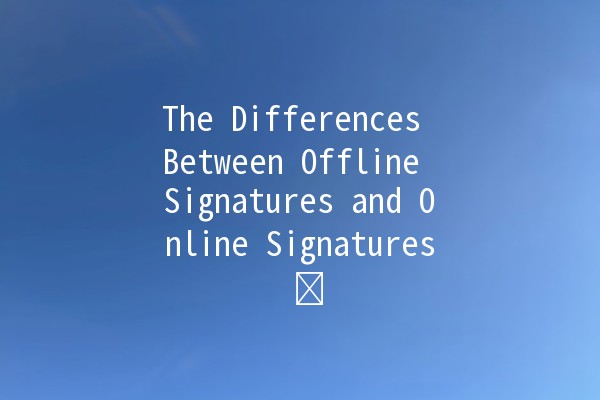
In the digital age, as technology evolves, the way we sign documents has transformed significantly. Gone are the days when pen and paper were the only means of affixing one’s mark to a document. Nowadays, we often encounter two predominant methods of signing: offline signatures and online signatures, each with its unique characteristics, benefits, and legal implications. Understanding these differences is crucial for individuals and businesses alike, especially in today’s fastpaced environment where efficiency and security are paramount.
What is an Offline Signature?
An offline signature, typically handdrawn with a pen on a piece of paper, represents an individual’s consent, authorization, or acknowledgment. Such signatures have been the traditional method of endorsing documents for centuries. They are often used in legal contracts, agreements, checks, and various formal papers, adding a personal touch and a sense of authenticity.

Key Features of Offline Signatures:
What is an Online Signature?
An online signature, on the other hand, is a digital representation of one’s signature and can be applied to electronic documents using various technologies. Online signatures may come in forms such as typed names, scanned images of a handwritten signature, or even biometric data. They have gained immense popularity due to the rise of remote transactions and digital documentation.
Key Features of Online Signatures:
Main Differences Between Offline and Online Signatures
Offline Signatures: Require physical documentation and the presence of the signer.
Online Signatures: Can be executed on digital platforms from any location and do not require physical documents.
Offline Signatures: The signing process can be lengthy, involving the printing, signing, and scanning of documents.
Online Signatures: Facilitate faster agreement processes, often allowing multiple signers to complete documents simultaneously.
Both offline and online signatures can be legally binding. However, the legal framework for recognizing online signatures can vary by region and may require certain conditions to be met:
Offline Signatures: Universally recognized in most legal systems.
Online Signatures: Must comply with regulations such as the Electronic Signatures in Global and National Commerce (ESIGN) Act in the United States or the eIDAS regulation in the European Union.
Offline Signatures: Subject to forgery and may lack verification methods.
Online Signatures: Often enhanced with encryption and verification processes, making them harder to replicate and tamper with.
Offline Signatures: Involve physical resources such as paper, ink, and transportation.
Online Signatures: Promote a paperless environment, significantly reducing the carbon footprint.
Producing Quality Documents: Increasing Productivity with Signing Techniques
Incorporating both offline and online signatures can lead to improved productivity. Here are five specific productivityenhancing techniques you can utilize:
Description: Utilizing software for electronic signatures can streamline the signing process.
Example: Solutions like DocuSign or Adobe Sign allow users to create and send documents for signature quickly and track the signing status, enhancing workflow efficiency.
Description: Automate document generation to reduce the time spent on repetitive tasks.
Example: Using tools like PandaDoc can help create templates for frequently used documents, enabling faster execution for contracts.
Description: Integrating signing tools with project management platforms can centralize document tracking.
Example: By syncing online signature capabilities with platforms like Trello or Asana, teams can manage tasks and signatures all in one place.
Description: Store signed documents in a secure cloud environment for easy access.
Example: Using services like Google Drive or Microsoft OneDrive, individuals can keep all their signed documents organized and retrievable without clutter.
Description: Creating standardized templates for common agreements can save time.
Example: By preparing templates for transactions such as NDAs or service contracts, businesses can reduce the repetitive work involved in drafting personalized documents for each new deal.
Frequently Asked Questions
Yes, online signatures can be legally binding, provided they meet certain criteria established by laws such as the ESIGN Act in the U.S. and eIDAS in the EU. They must demonstrate the signer's intent and include appropriate verification components.
To enhance the security of online signatures, utilize reputable software that incorporates encryption, authentication measures, and audit trails. Choosing platforms that comply with international security standards can further ensure document safety.
Yes, you can digitize an offline signature by scanning or photographing it and then uploading it to an online signature platform. Many services allow you to save this signature for future use.
Many types of documents can be signed online, including contracts, agreements, forms, and official documents. However, it is important to check the regulations regarding specific document types in your jurisdiction, as some may require traditional signatures.
A scanned signature is simply an image of a handwritten signature digitized for electronic use. In contrast, a digital signature is a cryptographic version that provides more security and verifiability, ensuring the integrity of the signed document.
Absolutely! One of the advantages of online signatures is that many platforms allow for multiple signers. This feature makes it easier to handle documents requiring multiple approvals, reducing turnaround time significantly.
Understanding the differences between offline and online signatures is crucial for making informed choices regarding document signing methods. As technology continues to advance, embracing online signatures can lead to significant enhancements in efficiency, productivity, and security. By integrating the appropriate techniques into your workflows, you can ensure that your signing processes align with contemporary business needs while promoting a paperless future.

